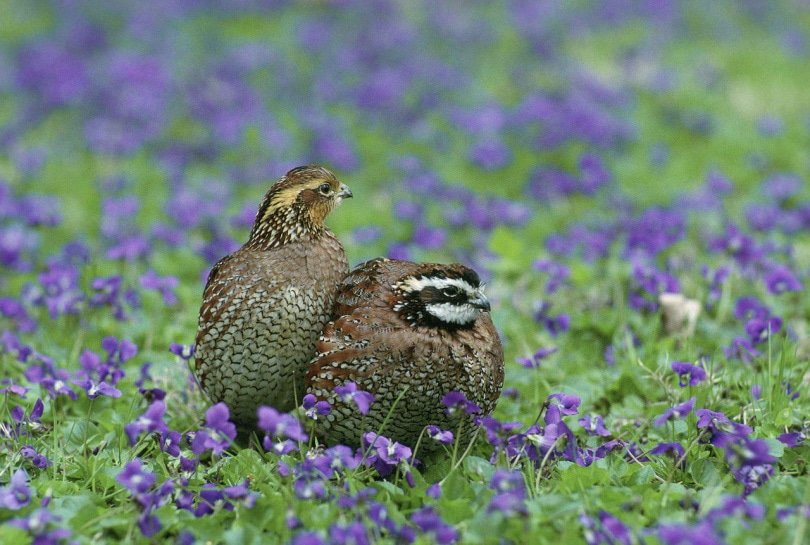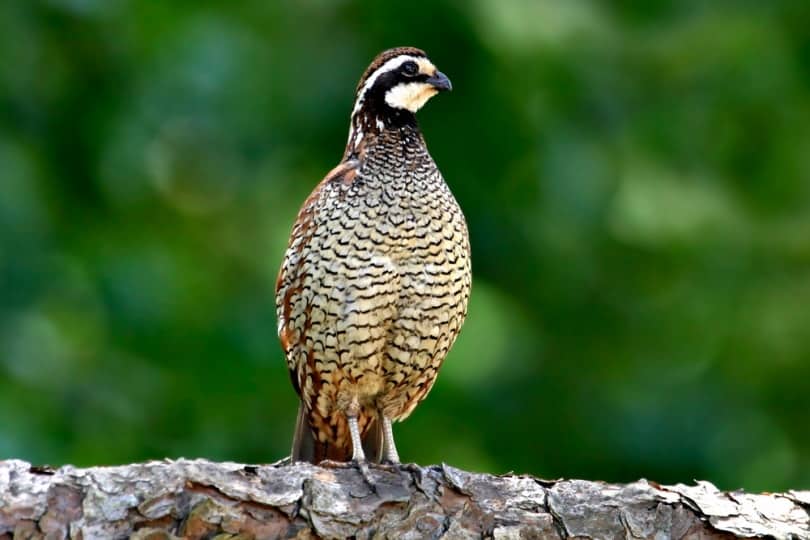Common inhabitants of the fields and forests of North America, Northern bobwhite quail can also be bred and raised in captivity. Offering multiple different income options for breeders and farmers, raising quail could be a sound business decision for many. Before you decide to add quail to your homestead, however, keep reading to learn more about them, including all the ways they can be used to make money!

Quick Facts About Northern Bobwhite Quail
| Breed Name: | Northern bobwhite, Eastern bobwhite, Virginia bobwhite |
| Place of Origin: | Central and North America, the Caribbean |
| Uses: | Eggs, meat, hunting |
| Cock (Male) Size: | 8 – 10 inches long |
| Hen (Female) Size: | 8 – 10 inches long |
| Color: | Brown, white, buff, black markings |
| Lifespan: | 1 – 3 years |
| Climate Tolerance: | Most climates, with adequate shelter |
| Care Level: | Easy |
| Production: | 150 – 200 eggs/year |

Northern Bobwhite Quail Origins
Northern bobwhite quail are native to Canada, the United States, Mexico, down into Central America, as well as several Caribbean islands including Cuba. Their numbers in the wild have declined over the past several decades and they have disappeared entirely from the most northern parts of their original range.
Currently, Northern bobwhites are found as far north as southern Michigan and Minnesota, west to Colorado and New Mexico, and south to Florida, the Caribbean, and Guatemala. There are also several subspecies of Northern bobwhite, including one found in Arizona and Mexico.
Northern Bobwhite Quail Characteristics
Northern bobwhites are named after the sound of their whistled “bob-white” call. Because they prefer to keep cover and with coloring designed to blend into their natural habitat, wild Northern bobwhites are more likely to be seen than heard.
In the wild, Northern bobwhites make their nests in the spring, with both males and females tending the nest and raising the hatchlings. Previously, bobwhites were thought to be monogamous but more recent research suggests both males and females take several mates during a breeding season.
Quail live as a family group during the breeding season but in fall and winter, will form coveys, groups of about 12 birds, who feed and roost together.
The natural habitat of Northern bobwhites is a mix of open and sheltered spaces, including farmland, overgrown fields, brushy meadows, and forest edges. They need open areas to forage but prefer to build nests and roost in sheltered spots, especially in cold weather.
Northern bobwhites forage for seeds, insects, grass, acorns, spiders, and snails. Their diet varies based on what is seasonally available to them. Although they can fly, they spend most of their time on the ground because their wings are short and not very efficient.
In captivity, adult Northern bobwhite quail can be kept confined or in fully enclosed outdoor pens with shelter, depending on what they’re being raised to provide. They are hardy birds and easy to care for.

Uses
Wild Northern bobwhite quail are extremely popular game birds for hunting. Because of the decline in the wild population, many captive bobwhites are used to breed young birds for reintroduction into the wild or to stock hunting preserves. Sometimes, landowners will choose not to raise captive quail but to create suitable habitat on their property to attract wild bobwhites for hunting.
Northern bobwhites are raised for meat and eggs, both of which are popular and considered a delicacy. Quail keepers may also hatch and sell quail chicks for additional income.

Appearance & Varieties
Northern bobwhite quail have round, stubby bodies with short tails, wings, and necks. Their body feathers are patterned in a mix of black, brown, and white. Both males and females have a crest on their heads which they use to attract mates.
However, male and female bobwhites do have some color differences. Males have a white stripe at their throat and eyes while females have similar stripes but in a light brown color.
There are 22 different sub-species of Northern bobwhite quail, including many that used to be classified as separate species. The appearance of the males of these sub-species varies widely but most of the females look similar to each other.
When they hatch, bobwhite chicks are covered in fuzzy down. By two weeks of age, they have enough feathers to fly and reach full size by 3-4 months.

Population
The wild population of Northern bobwhite quail declined by 85% between 1966 and 2014, at a rate of about 4% per year. The species overall is considered near threatened, or common but in steep decline. One subspecies, the masked bobwhite, is considered endangered.
Habitat loss is the primary culprit behind declining Northern bobwhite populations. Because they prefer a mixed or edge habitat, bobwhites are impacted both by loss of woodlands and modern changes in farming practices, which resulted in fields lacking cover and farmlands covered in pesticides and herbicides.
Are Northern Bobwhite Quail Good for Small-Scale Farming?
Northern bobwhite quail are inexpensive to raise and produce both eggs and meat quickly. They don’t require a lot of space and are quiet birds compared to domestic poultry like chickens. This makes them an excellent choice for small-scale farming or backyard homesteaders.
Bobwhites do need to be kept in a completely enclosed area to prevent escape. If raising quail for release into the wild, the young birds need to spend time in a flight pen to get in proper condition before heading out into the world.

Conclusion
While quail might not be the first bird that comes to mind when you consider stocking a backyard farm, Northern bobwhites offer a lot of benefits with relatively few risks. Why not look beyond the predictable options like chickens and consider raising these birds instead? Not only could you help yourself and your bank account, but you could also play a role in helping stabilize the population of this threatened species.
See also:
Featured Image Credit: Ronnie Howard, Shutterstock
